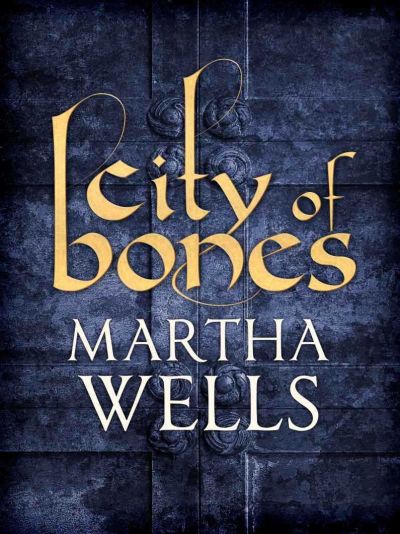Whisper Whisper
City of Bones
By Martha Wells

26 Feb, 2019
Martha Wells’ 1995 City of Bones is a standalone secondary-world fantasy.
The relic trade is chancy enough, but for krismen like Khat in a city like Charisat, it is especially risky. Even if Khat can avoid violating Charisat’s trade laws, he could still be murdered by greedy criminals … or off-handedly killed by the city guard or their masters. He is, after all, a despised non-human.
Too bad that there are so few jobs open to Khat. This is the best of the few; as a krisman, he has some advantages.
Ages ago, the Ancients’ world ended with an apocalypse. The seas vanished and once-fertile land was replaced by monster-filled wastes. The humans were reduced to a few survivors in a few lucky cities. In the centuries since the disaster, the cities have recovered, to an extent, but in all of them, resources are limited. The unlucky poor are pushed out into the waste to die.
Krismen, however, are well adapted to life in the wastes. (This is one of several reasons that the humans hate them.) If one is in the business of finding and selling relics, a guide whose natural gifts allow them to wander the desert in comparative safety is quite useful.
Khat is does not trust the upper-tier scholar who hires him for a relic-hunting foray to a ruined Ancient city. In fact, Khat is fairly certain that his patrician employer or their guards will try to kill him as soon as his usefulness ends; the hints that his employer is a magically adept Warder suggest even greater danger, as Warders are known to occasionally be driven mad by their magic. Still, work is work. Khat hopes that his skills will suffice to keep him alive.
One bandit raid later and the Warder’s guards are no longer a factor. Even if Elen had planned to kill Khat, she’s now dependent on him for survival. In fact, she’s so dependent on Khat she is forced to divulge some details of her research. Together, the pair dodge bandits and hunt Ancient secrets in the ruins.
If the story ended there, it would be a heart-warming tale of how people can overcome differences provided they have absolutely no choice in the matter. It does not end there. Instead, the alliance of necessity draws Khat into upper tier affairs. He discovers that a secret scheme might doom the new world as it was doomed in the Ancients’ time.
~oOo~
Once again, we learn why it is that prudent cultures will encourage young people to talk openly about their interest in archaeology … and then discourage them. Otherwise they’ll grow up and commit archaeology, digging up THAT WHICH SHOULD REMAIN BURIED.
[Originally I proposed all archaeologists should be ejected into parallel dimensions. It has been pointed out to me that no archaeologist would agree to this. Their intransigence in this matter proves its necessity!]
The krismen are a created race, infertile with humans1 and manifestly better suited to the world as it is than the people whose ancestors transformed the planet into a wasteland. One of the more annoying krismen traits (from the perspective of the magic-using Warders) is a total immunity to mental manipulation via magic. (Some of the Warders take this as proof that krismen lack souls.) Events in this tale suggest reasons why the species designer might have considered that a useful feature. I do not recall that the krismen character was ever impolite enough to discuss this with the humansalso1.
I was reminded of another recent read, Scott’s space opera Finders. Both novels feature people who live in the ruins left by greater civilizations and make a living finding and selling powerful relics they don’t completely understand. Both books spend a lot of time on personal relationships: romantic in Finders and platonic in City of Bones. For the record, I liked both books.
Wells takes a slow, sidelong approach to the world-threatening schemes that set the plot in motion. She starts with Khat and his struggle to survive in a hostile city. As Khat gradually learns what’s what, so does the reader. The first two thirds of the novel proceed at a studied pace before the narrative shifts into high gear. That was fine by me. I had time to care about Khat and Elen, as well as Khat’s circle of friends.
City of Bones is available here (Amazon), here (Amazon.ca) and here (Chapters-Indigo).
1: I generally assume, until told otherwise, that characters in secondary universe fantasies are human. However, I’m not sure that’s a reasonable assumption. Particularly in this case. The krismen are explicitly described as non-human. But are the so-called humans in this book authentic Homo Sapiens? Why would beings in another universe be just like us? Perhaps the narrative left out details that would have assured us that the “humans” are just as alien as the pouch-bearing krismen.
